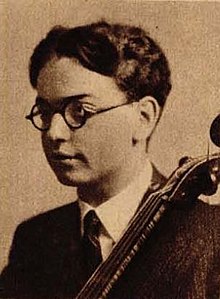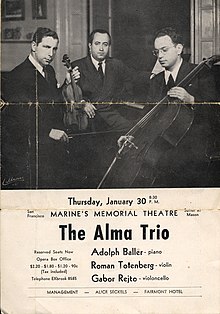| Revision as of 01:11, 19 June 2020 editRevirvlkodlaku (talk | contribs)Extended confirmed users83,878 editsm Cleaned up using AutoEd← Previous edit | Latest revision as of 02:56, 15 August 2024 edit undoGreenC bot (talk | contribs)Bots2,548,646 edits Rescued 1 archive link; Move 1 url. Wayback Medic 2.5 per WP:URLREQ#articles.latimes.com | ||
| (7 intermediate revisions by 5 users not shown) | |||
| Line 1: | Line 1: | ||
| {{short description|Hungarian cellist (1916–1987)}} | {{short description|Hungarian cellist (1916–1987)}} | ||
| {{Use dmy dates|date=February 2024}} | |||
| {{Infobox musical artist | {{Infobox musical artist | ||
| ⚫ | | background = person | ||
| | honorific_prefix = | |||
| | name = | | name = Gábor Rejtő | ||
| ⚫ | | image = Rejtő Gábor.jpg | ||
| | honorific_suffix = | |||
| ⚫ | | image = | ||
| | image_upright = | | image_upright = | ||
| | image_size = | | image_size = | ||
| | landscape = <!-- yes, if wide image, otherwise leave blank --> | | landscape = <!-- yes, if wide image, otherwise leave blank --> | ||
| | alt = | | alt = Sepia image of left profile of Gábor Rejtő holding cello | ||
| | caption = | | caption = Rejtő in 1935 | ||
| ⚫ | | background = |
||
| | native_name = Gábor Rejtő | |||
| | native_name_lang = ] | |||
| | birth_name = | | birth_name = | ||
| | alias = | | alias = | ||
| | birth_date = {{Birth date|1916|01|23|df= |
| birth_date = {{Birth date|1916|01|23|df=y}} | ||
| | birth_place = ], Hungary | | birth_place = ], Hungary | ||
| | origin = | | origin = | ||
| | death_date = {{Death date and age|1987|06|26|1916|01|23|df= |
| death_date = {{Death date and age|1987|06|26|1916|01|23|df=y}} | ||
| | death_place = | | death_place = | ||
| | genre = {{hlist|]|]}} | | genre = {{hlist|]|]}} | ||
| Line 25: | Line 22: | ||
| | years_active = <!-- YYYY–YYYY (or –present) --> | | years_active = <!-- YYYY–YYYY (or –present) --> | ||
| | label = | | label = | ||
| | associated_acts = | |||
| | website = <!-- {{URL|example.com}} or {{Official URL}} --> | | website = <!-- {{URL|example.com}} or {{Official URL}} --> | ||
| }} | }} | ||
| '''Gabor Rejto''' (23 January 1916 – 26 June 1987)<ref>{{cite news|title= Gabor Rejto; Cellist, USC Professor|date= |
'''Gábor Rejtő''', also known as '''Gabor Rejto''' (23 January 1916 – 26 June 1987),<ref>{{cite news|title= Gabor Rejto; Cellist, USC Professor|date=30 June 1987|access-date=30 January 2019|url=https://www.latimes.com/archives/la-xpm-1987-06-30-me-1148-story.html|newspaper=]}}</ref> was a Hungarian ] who performed with various artists and chamber music ensembles in the 20th century.<ref>{{cite web |title=Gabor Rejto, Cellist 1916-1987 |url=http://www.cello.org/heaven/bios/rejto.htm |website=cello.org |date= |accessdate=18 June 2020 |archive-date=16 April 2009 |archive-url=https://web.archive.org/web/20090416072743/http://www.cello.org/heaven/bios/rejto.htm |url-status=dead }}</ref> | ||
| ==Biography== | ==Biography== | ||
| ===Early life=== | ===Early life=== | ||
| Rejtő was born in ] into a Jewish family.<ref>Tibor Frank, ''Double Exile: Migrations of Jewish-Hungarian Professionals Through Germany to the United States, 1919-1945'', Peter Lang (2008), p. 449</ref> His first cello teacher was Frederick Teller, a local teacher whose ideas, for the time, were exceptionally forward-looking. At sixteen, Rejtő entered the Academy of Music under ] (a pupil of and later assistant to ]), and two years later, with his Artist’s Diploma, he began his European concert career. | |||
| ===Education=== | ===Education=== | ||
| From the age of 20, |
From the age of 20, Rejtő studied with ] for two years, first in ] and then in ]. Casals had revolutionized the approach to the cello and when he worked with Rejtő, they spent almost a month on just basic technique. Rejtő then played in concerts throughout Europe, with major symphony orchestras such as those in ], ], ], and ], as well as in solo recitals. | ||
| ===Career=== | ===Career=== | ||
| ] | ] | ||
| In 1952, |
In 1952, Rejtő and ] undertook a tour of New Zealand together. Over a period of five weeks, they gave twenty-five concerts to great critical acclaim.<ref>{{cite web|url=http://www.yaltahmenuhin.com/YaltahAndGabor.html|archive-url=https://web.archive.org/web/20150727013714/http://www.yaltahmenuhin.com/YaltahAndGabor.html|url-status=dead|archive-date=27 July 2015|title=Yaltah And Gabor}}</ref> | ||
| Rejto was a resident of the United States from 1939 until his death. During his career, he was on the faculty of the ] and ] Schools of Music. From 1954 to his death, he was professor of cello at the ]. He was also one of the cellists in the ] and the ], and was a founding member of the ], a piano trio, and remained with that ensemble from 1942 until it disbanded in 1976; in the early 1980s, the trio reformed, with Rejto again as the cellist. Rejto taught for a number of years at the ] summer program for gifted students, where his ]es were extremely popular, not just with cellists. His experience in chamber music attracted many students to his cello workshops held throughout the United States. | Rejto was a resident of the United States from 1939 until his death. During his career, he was on the faculty of the ] and ] Schools of Music. From 1954 to his death, he was professor of cello at the ]. He was also one of the cellists in the ] and the ], and was a founding member of the ], a piano trio, and remained with that ensemble from 1942 until it disbanded in 1976; in the early 1980s, the trio reformed, with Rejto again as the cellist. Rejto taught for a number of years at the ] summer program for gifted students, where his ]es were extremely popular, not just with cellists. His experience in chamber music attracted many students to his cello workshops held throughout the United States. | ||
| In 1972, |
In 1972, Rejtő was chosen ''Artist Teacher of the Year'' at the ]'s 25th Anniversary Conference.<ref>{{cite journal|url=http://www.astaweb.com/App_Themes/Public/Uploads/August2011journal.pdf|journal=American String Teacher|volume=61|number=3|date=August 2011|title=Awards & Citations}}</ref> | ||
| ===Family=== | ===Family=== | ||
| Rejtő's son, Peter Rejto, is a cellist and a former faculty member at the ]. He was a founding member of the Los Angeles Piano Quartet. Gábor Rejtő's daughter, Nika S. Rejto, is a jazz flutist. She released an album entitled ''Teazing Socrates'' in 2006, dedicated to her late father. | |||
| ==See also== | ==See also== | ||
| Line 82: | Line 79: | ||
| ] | ] | ||
| ] | ] | ||
| ] | |||
Latest revision as of 02:56, 15 August 2024
Hungarian cellist (1916–1987)
| Gábor Rejtő | |
|---|---|
 Rejtő in 1935 Rejtő in 1935 | |
| Background information | |
| Born | (1916-01-23)23 January 1916 Budapest, Hungary |
| Died | 26 June 1987(1987-06-26) (aged 71) |
| Genres | |
| Occupation | Musician |
| Instrument | Cello |
Gábor Rejtő, also known as Gabor Rejto (23 January 1916 – 26 June 1987), was a Hungarian cellist who performed with various artists and chamber music ensembles in the 20th century.
Biography
Early life
Rejtő was born in Budapest into a Jewish family. His first cello teacher was Frederick Teller, a local teacher whose ideas, for the time, were exceptionally forward-looking. At sixteen, Rejtő entered the Academy of Music under Adolf Schiffer (a pupil of and later assistant to David Popper), and two years later, with his Artist’s Diploma, he began his European concert career.
Education
From the age of 20, Rejtő studied with Pablo Casals for two years, first in Barcelona and then in Prades. Casals had revolutionized the approach to the cello and when he worked with Rejtő, they spent almost a month on just basic technique. Rejtő then played in concerts throughout Europe, with major symphony orchestras such as those in Vienna, Budapest, Rome, and Warsaw, as well as in solo recitals.
Career

In 1952, Rejtő and Yaltah Menuhin undertook a tour of New Zealand together. Over a period of five weeks, they gave twenty-five concerts to great critical acclaim.
Rejto was a resident of the United States from 1939 until his death. During his career, he was on the faculty of the Manhattan and Eastman Schools of Music. From 1954 to his death, he was professor of cello at the University of Southern California. He was also one of the cellists in the Paganini Quartet and the Hungarian Quartet, and was a founding member of the Alma Trio, a piano trio, and remained with that ensemble from 1942 until it disbanded in 1976; in the early 1980s, the trio reformed, with Rejto again as the cellist. Rejto taught for a number of years at the Music Academy of the West summer program for gifted students, where his master classes were extremely popular, not just with cellists. His experience in chamber music attracted many students to his cello workshops held throughout the United States.
In 1972, Rejtő was chosen Artist Teacher of the Year at the American String Teachers Association's 25th Anniversary Conference.
Family
Rejtő's son, Peter Rejto, is a cellist and a former faculty member at the Oberlin Conservatory. He was a founding member of the Los Angeles Piano Quartet. Gábor Rejtő's daughter, Nika S. Rejto, is a jazz flutist. She released an album entitled Teazing Socrates in 2006, dedicated to her late father.
See also
Published mentions and biographies
References
- "Gabor Rejto; Cellist, USC Professor". Los Angeles Times. 30 June 1987. Retrieved 30 January 2019.
- "Gabor Rejto, Cellist 1916-1987". cello.org. Archived from the original on 16 April 2009. Retrieved 18 June 2020.
- Tibor Frank, Double Exile: Migrations of Jewish-Hungarian Professionals Through Germany to the United States, 1919-1945, Peter Lang (2008), p. 449
- "Yaltah And Gabor". Archived from the original on 27 July 2015.
- "Awards & Citations" (PDF). American String Teacher. 61 (3). August 2011.
External links
- Gabor Rejto discography at CD Universe
- Alibris Classical Music - CDs by Gabor Rejto
- The Los Angeles Piano Quartet
- Nika Rejto
Gabor Rejto students
Categories: